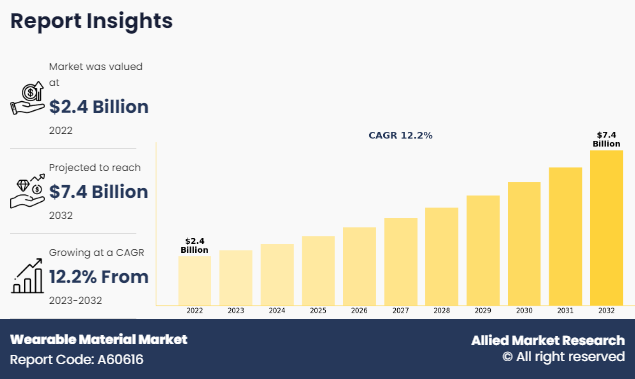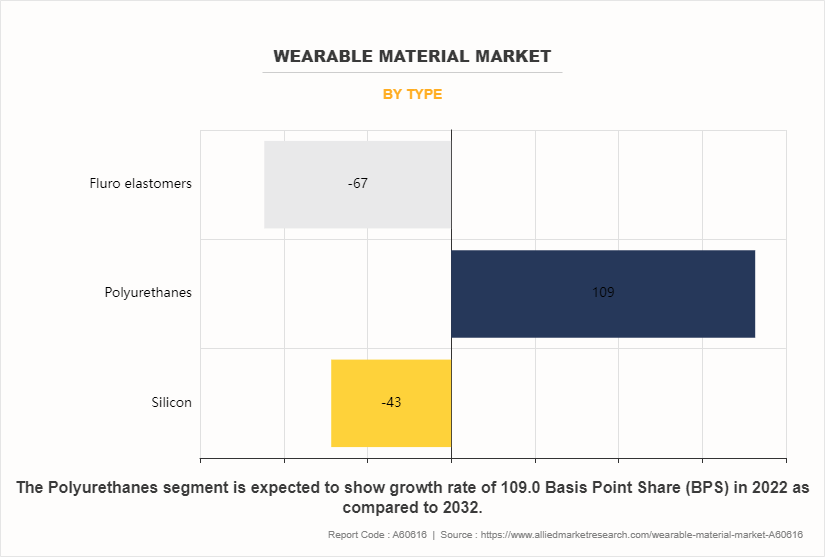Wearable Material Market Research, 2032
The global wearable material market was valued at $2.4 billion in 2022, and is projected to reach $7.4 billion by 2032, growing at a CAGR of 12.2% from 2023 to 2032. Continuous advancements in material science and technology, including the development of flexible and lightweight materials, drive innovation in wearable technology.

Introduction
Wearable materials refer to substances or fabrics specifically designed and engineered to be worn comfortably on the body. These materials are chosen for their ability to provide both comfort and functionality in various wearable applications, such as clothing, accessories, or electronic devices. They often possess characteristics such as flexibility, breathability, durability, moisture-wicking properties, and sometimes even advanced functionalities such as stretchability, water resistance, or antimicrobial properties. Examples of wearable materials include cotton, polyester, nylon, spandex, leather, silicone, conductive textiles, and various advanced textiles incorporating smart or interactive features. Wearable materials play a crucial role in enhancing the user experience and performance of wearable products across different industries, including fashion, sports, healthcare, and technology.
Key Takeaways:
- The report provides competitive dynamics by evaluating business segments, product portfolios, target market revenue, geographical presence and key strategic developments by prominent manufacturers.
- In this report, we have explored the drivers, restraints, and opportunities shaping the trajectory of this market. From technological advancements to evolving consumer preferences, the wearable material market is at the nexus of innovation and demand, offering immense potential for stakeholders across industries.
- The wearable materials market is fragmented in nature among prominent companies such as BASF SE, 3M, Covestro, Lydall Performance Materials, Bally Ribbon Mills, Avery Dennison, Toray Industries, Koninklijke Ten Cate BV, Teijin Limited, and Nano Dimension.‐¯‐¯
- The study contains qualitative information such as the market dynamics (drivers, restraints, challenges, and opportunities), key regulation analysis, pricing analysis, and Porter’s Five Force Analysis across North America, Europe, Asia-Pacific, LAMEA regions.
- Latest trends in global wearable materials market such as undergoing R&D activities, regulatory guidelines, and government initiatives are analyzed across 16 countries in 4 different regions.
- More than 3,000 wearable materials-related product literatures, industry releases, annual reports, and other such documents of key industry participants along with authentic industry journals and government websites have been reviewed for generating high-value industry insights for global wearable materials market.
Market Dynamics:
Technological advancements represent one of the primary drivers of innovation in the wearable materials market. Breakthroughs in material science, nanotechnology, and electronics have enabled the development of advanced materials with properties such as flexibility, durability, conductivity, and biocompatibility. For instance, the emergence of smart textiles, which integrate electronics and sensors into fabrics, has opened new possibilities for wearable devices in healthcare, sports, and fashion sectors. According to an article published by Forbes in 2022, gesture control is one of the new features that will soon be available with wearable tech devices. This may increase the sales for wearable devices in the coming future; thus, fueling the growth of the wearable materials market.
Materials such as conductive textiles, stretchable polymers, and biocompatible coatings have gained traction due to their compatibility with wearable electronics and sensors. These materials enable the seamless integration of sensors for health monitoring, fitness tracking, and biometric authentication into clothing and accessories. Furthermore, advancements in manufacturing techniques such as 3D printing and additive manufacturing have facilitated the production of complex geometries and customized designs, driving innovation in wearable material applications.
Changing consumer lifestyles and preferences has also contributed to the growth of the wearable materials market. Rise in adoption of wearable devices for health and fitness tracking, as well as for lifestyle and entertainment purposes, has created a demand for comfortable, lightweight, and aesthetically pleasing materials. Consumers seek products that offer functionality without compromising on style or comfort, driving manufacturers to innovate in material design and integration.
Moreover, rise in awareness of health and wellness has led to the popularity of smart clothing and accessories embedded with biometric sensors, temperature regulators, and moisture-wicking fabrics. Wearable materials that provide breathability, moisture management, and antimicrobial properties are favored by consumers seeking comfort and hygiene in their activewear and everyday clothing.
In addition, rise of wearable technology in fashion and personal expression has led to collaborations between fashion designers, technology companies, and material innovators. This convergence of industries has spurred creativity in material selection and design, resulting in wearable products that blend functionality with fashion-forward aesthetics.
However, one of the primary restraints in the wearable materials market is the cost associated with developing and manufacturing wearable devices. Advanced materials, sensors, and technologies used in wearables often come at a high price, making these devices unaffordable for a significant portion of the population, particularly in emerging markets. Moreover, the cost of research and development further adds to the overall expenses.
On the contrary, wearable materials hold immense potential in revolutionizing healthcare delivery and patient monitoring. From remote patient monitoring systems to wearable medical devices for chronic disease management, the healthcare sector stands to benefit significantly from the integration of wearable technologies. Wearable biosensors, smart patches, and textile-based sensors enable continuous monitoring of vital signs, medication adherence, and early detection of health issues, thereby improving patient outcomes and reducing healthcare costs.
Segments Overview:
The wearable materials market is segmented on the basis of type, application, and region. On the basis of type, the market is categorized into silicon, polyurethanes, and Fluro elastomers. By application, the market is divided into consumer electronics, medical, and others. Region-wise, the market is studied across North America, Europe, Asia-Pacific, and LAMEA.

In 2022, the polyurethanes segment was the largest revenue generator, and is anticipated to grow at a CAGR of 12.4% during the forecast period. Polyurethane (PU) is a highly versatile material that can be tailored to meet various performance requirements. It can be formulated to be soft and flexible or rigid and durable, making it suitable for a wide range of wearable applications such as clothing, footwear, fitness trackers, smartwatches, and medical devices. Moreover, polyurethane materials offer excellent comfort and performance characteristics. They are lightweight, breathable, and provide a good level of flexibility, which enhances wearer comfort, especially in wearable devices that are worn close to the body for extended periods.

By application, the consumer electronics segment dominated the global market in 2022, and is anticipated to grow at a CAGR of 12.4% during the forecast period. Wearable electronics, such as smartwatches, fitness trackers, and augmented reality glasses, are experiencing rapid technological advancements. These advancements include improvements in sensors, battery life, connectivity, and data processing capabilities. As a result, there is a growing need for advanced materials that can support and enhance the performance of these sophisticated electronic devices.
Furthermore, consumers are increasingly demanding wearable devices that not only offer advanced functionality but also look stylish and fashionable. Materials with customizable colors, textures, and finishes allow manufacturers to create wearable electronics that appeal to a wide range of consumer tastes and preferences.

The Asia-Pacific wearable materials market size is projected to grow at the highest CAGR of 12.8% during the forecast period and accounted for 39.4% of wearable materials market share in 2022. The Asia-Pacific region, particularly countries like China, India, Japan, and South Korea, has been experiencing rapid economic growth over the past few decades. This growth has led to an increase in disposable income and consumer spending, driving demand for consumer electronics, including wearable devices. Furthermore, the Asia-Pacific region is home to a significant portion of the world's population, including a growing middle class with increasing purchasing power. The large population base provides a substantial market for wearable devices, creating opportunities for manufacturers and suppliers of wearable materials.
Competitive Analysis:
The global wearable materials market profiles leading players that include BASF SE, 3M, Covestro, Lydall Performance Materials, Bally Ribbon Mills, Avery Dennison, Toray Industries, Koninklijke Ten Cate BV, Teijin Limited, and Nano Dimension.
Other key players involved in the manufacturing of wearable materials include Wacker Chemie AG, Solvay, The Lubrizol Corporation, Arkema SA, Rogers Corporation, Trelleborg Group, and others. The global wearable materials market report provides in-depth competitive analysis as well as profiles of these major players.
Key Developments in Wearable Material Market:
In 2024, Trelleborg Group acquired silicon manufacturing business from Baron Group. This strategic acquisition has enhanced the product portfolio of Trelleborg Group for silicon-based wearable materials.
In 2022, Rogers Corporation acquired Silicone Engineering Ltd., a leading European manufacturer of silicone material solutions based in Lancashire, UK. This strategic acquisition has enhanced the product offering of Rogers Corporation for wearable materials.
Key Benefits For Stakeholders
- This report provides a quantitative analysis of the market segments, current trends, estimations, and dynamics of the wearable material market analysis from 2022 to 2032 to identify the prevailing wearable material market opportunities.
- The market research is offered along with information related to key drivers, restraints, and opportunities.
- Porter's five forces analysis highlights the potency of buyers and suppliers to enable stakeholders make profit-oriented business decisions and strengthen their supplier-buyer network.
- In-depth analysis of the wearable material market segmentation assists to determine the prevailing market opportunities.
- Major countries in each region are mapped according to their revenue contribution to the global market.
- Market player positioning facilitates benchmarking and provides a clear understanding of the present position of the market players.
- The report includes the analysis of the regional as well as global wearable material market trends, key players, market segments, application areas, and market growth strategies.
Wearable Material Market Report Highlights
| Aspects | Details |
| Forecast period | 2022 - 2032 |
| Report Pages | 510 |
| By Type |
|
| By Application |
|
| By Region |
|
| Key Market Players | Lyndall Performance Materials, BASF SE, 3M, TEIJIN LIMITED., Covestro AG., Bally Ribbon Mills, AVERY DENNISON CORPORATION, Nano Dimension Ltd., TORAY INDUSTRIES, INC., Koninklijke Ten Cate BV |
Analyst Review
According to CXOs of leading companies, the wearable material market is characterized by a dynamic interplay of drivers, restraints, and opportunities that are shaping its evolution. From technological advancements and changing consumer preferences to regulatory challenges and emerging markets, the landscape of wearable technology is vast and multifaceted. By embracing innovation, addressing challenges, and capitalizing on opportunities, stakeholders in the wearable material market can unlock new avenues for growth and deliver transformative solutions that enhance the lives of consumers worldwide. As the market continues to evolve, collaboration, agility, and a commitment to excellence will be essential for success in this fast-paced and competitive industry.
Technological advancements, growing health awareness, growing lifestyle trends, and increasing fashion and style preferences are the upcoming trends of wearable material market in the world.
Consumers electronics is the leading application of wearable material market.
Asia-Pacific is the largest regional market for wearable material.
The global wearable materials market was valued at $2.4 billion in 2022 and is estimated to reach $7.4 billion by 2032, exhibiting a CAGR of 12.2% from 2023 to 2032.
BASF SE, 3M, Covestro, Lydall Performance Materials, Bally Ribbon Mills, Avery Dennison, Toray Industries, Koninklijke Ten Cate BV, Teijin Limited, and Nano Dimension are the top companies to hold the market share in wearable material market.
Loading Table Of Content...
Loading Research Methodology...


